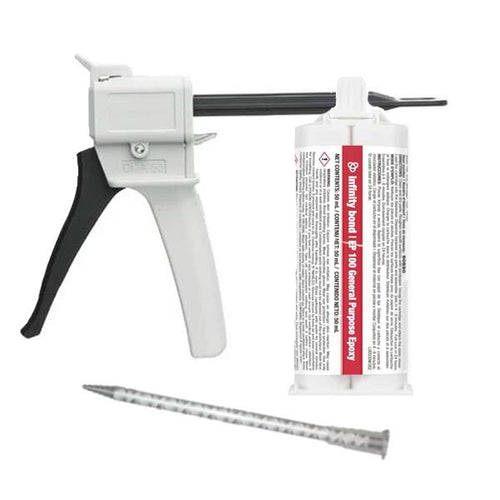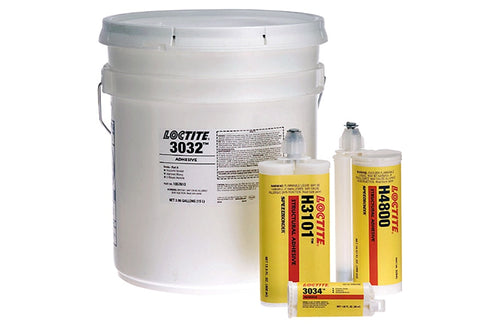Bonding Aluminum: Find the Best Adhesives for Aluminum
Aluminum is a type of lightweight, soft, and malleable metal. It is less dense than steel, but it has a high strength-to-weight ratio. This strength combined with its high thermal conductivity, good corrosion resistance, and affordable price makes aluminum a great metal for various industrial applications. Aluminum alloys also allow for more diverse applications.
Gluing Aluminum
Bonding aluminum can be a bit tricky because it may have an additional layer on the outside that can interfere with the bond. Because aluminum readily reacts with oxygen, this reaction can form a layer of aluminum oxide on the surface that is invisible to the naked eye. While adhesives can bond well to the oxide, this layer may not bond well to the aluminum material itself. As a result, companies may experience what they believe to be bond failure when in fact the aluminum separated from the oxide layer, not the adhesive. This oxidized aluminum can also decrease the aluminum’s lap shear strength, or how much force is required to separate two substrates when they are pulled in opposite directions.
The Best Glues for Aluminum
Especially when it comes to industrial applications, you need a high-strength adhesive that will be able to create lasting bonds with aluminum. While every application is unique, below are a few of our recommendations for the best adhesives for aluminum.
-
![Infinity Bond EP 420 High Peel and Shear Strength Epoxy - 25 Minute Open Time]()
EP 420 Epoxy
This epoxy is great for metals in general as well as many other types of substrates. It forms high-strength bonds that are built to last because of its good flexibility and temperature-resistant properties. It also has a slow set time and fixture time of 120 minutes to allow for adjustments in the production process. A compatible cartridge gun is required for successful application.
-
![MMA 420 Toughened Impact Resistant MMA Adhesive - 5 Minute Open Time]()
Infinity Bond MMA 420
Another good adhesive for aluminum, this MMA has a toughened formula for greater impact and shock resistance. The product is also temperature resistant and requires minimal surface preparation for ease of application. The set speed of about 5 minutes is great for high-volume production, and the adhesive can be used in various different types of applications.
-
![Henkel Loctite AA H8100 490 ml Cartridge]()
Loctite H8100 Aluminum Adhesive
This two-part adhesive is made with bonding aluminum substrates in mind. Not only is it impact resistant and cold resistant, but also it has a non-sag formulation for a high-quality look on the finished product. It has a fast fixture time, requires minimal surface preparation before application, and cures at room temperature.
Applications with Aluminum
Aluminum and aluminum alloys have many desirable properties and are used in an extensive number of industries because of it. Some common applications for aluminum include airplane parts, household goods, bus panels, building structures, and more.
Some of these applications require strong, structural bonds without the heavy weight of mechanical fasteners. In these cases, aluminum adhesives are typically the way to go.
Types of Aluminum Adhesives
There are so many adhesives available, but not every adhesive can bond to aluminum successfully. There are, however, a few types of adhesives that tend to be better at bonding aluminum substrates than other.
Some common adhesives for aluminum include:
- MMA adhesives - These adhesives typically involve minimal surface preparation and tend to have a cure time of a few minutes.
- Acrylic adhesives - Similar to MMAs in chemistry, acrylics are strong and can bond with various types of substrates.
- Epoxy adhesives - These adhesives typically come in two parts and have a high heat and chemical resistance. They may be the strongest adhesive for aluminum.
- Cyanoacrylate adhesives (super glue) - Cyanoacrylates are moisture curing adhesives that are known for their almost instantaneous bonding capabilities, but they tend to not have as good of impact resistance as structural adhesives.
It is important to also keep in mind that bonding abilities can vary from product to product, so not every MMA or epoxy will be a great adhesive for every aluminum application. To be sure the adhesive meets your needs, you should check the product’s technical data sheet or speak with an adhesive expert.
How to Bond Aluminum
Bonding aluminum together can come with its challenges, but the right preparation and aluminum adhesive can lead to a successful and lasting bond for many applications. Always follow the adhesive manufacturer's exact instructions in order to get the best results.
With aluminum in particular, surface preparation is imperative. Wiping down the aluminum with a solvent alone is usually not sufficient because of oxidation. Aluminum can also be susceptible to galvanic corrosion, or corrosion that occurs when the aluminum comes into electrical contact with another metal. This corrosion can lead to more oxidation of the aluminum. To prevent galvanic corrosion, the aluminum may need to be electroplated with metal that won’t corrode such as gold or nickel.
To prep the substrate before bonding, you should typically clean and degrease the aluminum using a solvent such as acetone, ketone, or something similar. Another option is to vapor degrease the aluminum with a chlorinated solvent.
Once the initial cleaning is done, the next step is usually roughing up the surface. This step can give the adhesives more surface to grip and improve adhesion. Sanding the surface can cause a lot of loose debris so cleaning it with an acid solution after is recommended.
Finally, rinse the surface and let it dry before applying the adhesive according to its instructions. Every product will have a recommended cure time and cure process. In many cases, adhesives for aluminum can cure overnight at room temperature.
Tips for Working with Aluminum Adhesives
Along with applying the aluminum glue correctly to get the strongest bond, you should also be mindful of applying it safely. Some glues for aluminum can contain toxic chemicals that can be a safety hazard. Typically, protective gear like glasses, gloves, and long sleeves/pants are recommended. The fumes from the adhesive may also be strong so well-ventilated workspaces are sometimes required.
Proper storage is another important factor to consider when working with adhesives for aluminum applications. The shelf life can vary greatly from one product to another, but it will only last this long if the adhesive is stored properly. Unsuitable storage temperatures or improper sealing of opened containers can quickly lead to premature curing or the adhesive not being as effective upon application.
Need More Help?
When trying to find the best adhesive for your aluminum-based application, it is important to consider a variety of factors including necessary strength, environment, cure time, budget, and more. If you are not sure what metal adhesive is best for your specific needs, we want to help. We have a team of adhesives experts that can provide you with a personalized product recommendation.
Recommended Products
Frequently Asked Questions
Not every adhesive can bond aluminum and capabilities vary from product to product, but there are a handful of types of adhesives that tend to be better suited for bonding aluminum than others.
Some common adhesives for aluminum include:
Ask a Question
Have questions? Our team of adhesive experts can help. Submit your questions and we'll get you answers right away. We're here to help.










